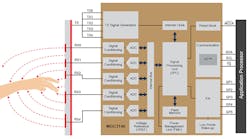3D Tracking and Gesture Controller Targets Automotive HMI
Gesture-recognition solutions have grabbed the attention of automotive human-machine-interface (HMI) designers. Simply, they allow drivers to easily control everything from switching on lights to answering phone calls while still focusing on the road.
To that end, Microchip announced its MGC3140, said to be the world’s first automotive-qualified three-dimensional (3D) tracking and gesture controller. The device enables a user interface with natural hand and finger movements in free space, utilizing the principles of electrical near-field sensing.
By way of review, E-fields are generated by electrical charges and propagate three-dimensionally around the surface, carrying the electrical charge. Applying direct voltages (dc) to an electrode results in a constant electric field. Applying alternating voltages (ac) makes the charges vary over time and, thus, the field. The result is a quasi-static electrical near-field that can be used for sensing conductive objects such as the human body.
In case a person’s hand or finger intrudes the electrical field, the field becomes distorted. The field lines are drawn to the hand due to the conductivity of the human body itself and shunted to ground.
Implemented as a low-power mixed-signal configurable controller, the MGC3140 provides a set of functional features, such as gesture recognition, while using adaptive working frequencies for robust performance in noisy environments. Existing solutions such as infrared and time-of-flight technologies can operate poorly in bright or direct sunlight; on the other hand, the MGC3140 offers reliable sensing in full sunlight and harsh environments.
GestIC
Microchip’s GestIC technology uses a minimum number of four receiver (Rx) electrodes to detect the E-field variations at different positions to measure the origin of the electric-field distortion from the varying signals received. The information is used to calculate the position, track movements, and classify movement patterns (gestures). GestIC technology uses five transmit (Tx) frequencies: 42, 43, 44, 45, and 100 kHz.
Block diagram of Microchip’s MGC3140, an automotive-qualified three-dimensional (3D) tracking and gesture controller.
The MGC3140 is being provided with a GestIC Library loader (bootloader) that’s stored on the chip’s flash memory. Using this loader, a GestIC Library can be flashed on the MGC3140 via I2C using, for example, an embedded host controller or Microchip's Aurea GUI.
The GestIC Library includes:
- Microchip’s Colibri Suite: Digital-signal-processing (DSP) algorithms and feature implementations; the Colibri Suite combines data acquisition, DSP, and interpretation.
- System control: MGC3140 hardware control.
The Colibri Gesture Suite is a library of GestIC technology features. It uses a Hidden Markov Model (HMM)-based gesture-recognition engine in conjunction with x/y/z hand-position tracking, flick, circle, and touch gestures. Thus, it can perform input commands such as open application, point, click, zoom, scroll, mouse-over, and many others without the need to touch the device.
The GestIC Colibri Suite is processed on-chip. It removes the need for host post-processing and reduces system power consumption, reducing software-development efforts to help shorten time-to-market.
The Colibri Suite’s Position Tracking feature offers 3D hand position over time and area. The absolute position data is provided according to the defined origin of the Cartesian coordinate system (x, y, z). Position Tracking data is continuously acquired in parallel to gesture recognition. With a position rate of up to 200 positions per second, a maximum spatial resolution of 150 dpi is achieved.
Another feature, Approach Detection, is a programmable function that scans for user activity while the chip is in self-wakeup mode. If real user interaction is detected, the system automatically switches into full-sensing mode and alternates back to wakeup mode once the user leaves the sensing area. As a result, always-on 3D gesture sensing can become a reality, even for battery-powered products.
Each 3D gesture system consists of a sensor that the company says can be constructed from any conductive material, as well as the Microchip gesture controller tuned for each individual application. The MGC3140 is AEC-Q100-qualified with an operating temperature range of −40 to +125°C, and it meets the strict electromagnetic-interference (EMI) and electromagnetic-compatibility (EMC) requirements of automotive system designs. It’s aimed at navigating infotainment systems, sun-shade operation, interior lighting, and other applications.
Design-in is supported by Microsoft’s Aurea graphical user interface (GUI), available from Microchip. The company’s DM160238 Emerald kit provides a convenient evaluation platform for the 3D gesture-recognition controller. The kit includes a reference printed circuit board (PCB) with the MGC3140 controller, a PCB-based sensor to recognize gestures, as well as all needed cables, software, and documentation.
The MGC3140 is available now in sampling and volume production quantities.


